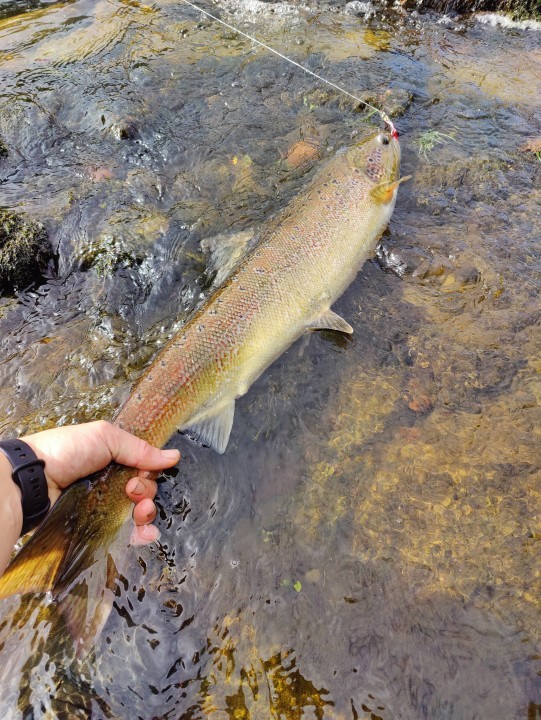 Upper Glangwye salmon - KG from Birmingham
Upper Glangwye salmon - KG from Birmingham We finished September with an afternoon of heavy rainfall, which in due course produced a rise of a foot in our upper rivers. Our old friend KG from Birmingham, who has a knack of predicting the right conditions for a late season salmon, came over once again on 2nd October and caught a coloured hen of 10 pounds, which was kept in the water and carefully released. He normally fishes Abernant, but he was on the Rectory this time and fishing the Upper Glangwye pool. I will admit to feeling a tinge of jealousy towards Kristof in this case, because I have always wanted a fish from that particular pool, but never got one.
The Rectory, incidentally, is currently up for sale, with formal tenders to be offered to Sunderlands of Hereford by October 28th. 250,000 to 300,000 is the guideline price according to Trout and Salmon. It is a remarkable salmon beat, with possibilities in different sections for virtually all water levels. There is also good trout and grayling fishing. I just suggested to the wife we sell the house and try for it; we could always live in the fishing hut. You can imagine I got a dusty answer!
Around this time I also saw some video clips circulated of migratory fish taken during raised water levels on the Towy and Loughor. I won’t pass them on because I have reservations about the catch and release methods displayed. Allow me to make these points. Please, if you are going to fish for salmon, make sure you use an adequately big net for the large fish. Have a set of long handled forceps ready. Once you have netted it, keep it in the water enveloped in the folds of the net while you release the hook and then let the fish go. Don’t carry it over to the gravel or grass and play with it there. Photography doesn’t matter. I don’t like to see salmon wriggling and kicking about on the gravel or grass and nor should you.
On the 2nd, LB from Stockbridge after a difficult day at Craig Llyn had a very good result at Lyepole, reporting 37 grayling on dry flies. Joe Alexander from Leominster put in another interesting report from Llyn Craigpistyll after catching 7 trout from this Central Wales mountain lake. Two more salmon were reported from the Cafn Pool of the Nyth, taken with a small Willie Gunn tube. Glanwye had a fish of 11 pounds. I would be prepared to bet that what we were seeing here was not a run, but a few long-term residents of the upper river stirred into action by the rise.
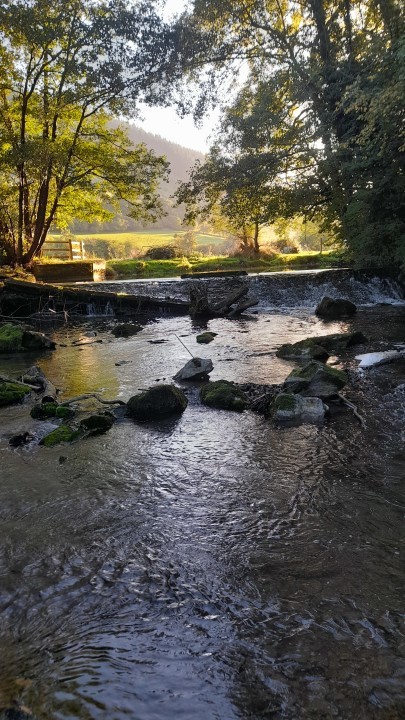 Lyepole - AW from Salisbury
Lyepole - AW from Salisbury MH from Swansea recorded a 2 pounds trout from the Rectory Neck in a catch of 4 trout from the Rectory. Then between the 4th and the 5th another front of wind and storm swept across from the West and this time the rain was enough to begin real floods, the first which looked like connecting to the swelling tides in the estuaries for many months. By the afternoon of the 5th the marker boards on the upper Wye and Usk were out of sight, while the Towy had already risen out of its channel and spread over the fields. While all this drama was going on, the Monnow remained unaffected, protected as is often the case by its situation on the rain shadow side of the Black Mountains. Similarly the Lugg, which depends mainly on its deep springs, continued to run low. GW from Cheltenham with a friend reported another large catch of grayling at Lyepole; DB from Cheltenham with a companion reported 20 and noted the usual signs of otter habitation (piles of crayfish claws!)
Now with both main rivers up and some full moon spring tides due, there seemed to be a reasonable expectation of late salmon running into fresh water. In fact it turned out to be relatively quiet on the lower sections, although long term residents stirred themselves further upstream. At Abernant, DM from Wrexham had a 33 inch coloured hen from Lady Alexander Catch on a Munro killer. MH from Bristol bucked the trend on the 9th with a clean cock fish of 13 pounds from the Nyth’s Cafn Pool on a small tube fly. Meanwhile the Lugg was still fishing exceptionally well for grayling: DH from Cheltenham had 19 at Eyton on the 9th and AW from Salisbury had 10 at Lyepole on the 10th.
The high water salmon conditions on the main rivers did not last for very long; by the end of the weekend the rivers were already dropping and clearing. We heard from two of our grayling regulars: on the 11th Dave Collins from West Herefordshire had a day at Abernant and caught 15 grayling to 14 inches, using about every known method and fly at different times and places. There was a lack of rising fish until late in the day, but he managed a few by prospecting likely flows with a Duck’s Dun. Also AG, who comes over every year from Harleston in Norfolk, and who fished the Irfon at Melyn Cildu the day before, fished at Gromaine and Upper Llanstephan. It was his first time on this beat which, as he discovered, has more rocks and gutters than gravel pools, and is thus better known for its salmon. He had been hoping for something like the Bachawy Pool at Ty Newydd (although even that has been damaged by last winter’s floods). However, he found himself one place - I am guessing the run in front of the fishing hut - which yielded him 10 grayling. The following day he had 9 grayling to 14 inches while nymphing the gutters at Doldowlod. Salmon fishing regular Stuart Macoustra had an interesting day on the 13th. Fishing the Usk at Chainbridge, he had a hard pull from a fish on a Curry’s Red Shrimp in Upper Rocks. Unfortunately it didn’t stick. He then went downstream to Newbridge in order to intercept a spring tide and had a coloured fish of 10 pounds on the same fly. On the 14th DT from Chester recorded 11 grayling on a Klinkhammer from the Ithon at Llandewi. MI from Bristol caught 8 grayling by nymphing at Craig Llyn. On the 15th AP from Carmarthen with a friend recorded a salmon and two sea trout from the Clwb Godrer Myndd Du. And on the 17th, last day of the salmon season. MH from Swansea had a cock salmon from Island Stream at the top of the Rectory. Stuart Macoustra oddly enough had a reverse experience to that of a few days before. He began the day with an Usk salmon of 18 pounds on a Reverend Mole from Newbridge; then went on to the Chainbridge beat where he had a pull in the Rock Pool – but no fish!
 Abernant Stream with a little extra water - JH from Cheltenham
Abernant Stream with a little extra water - JH from Cheltenham 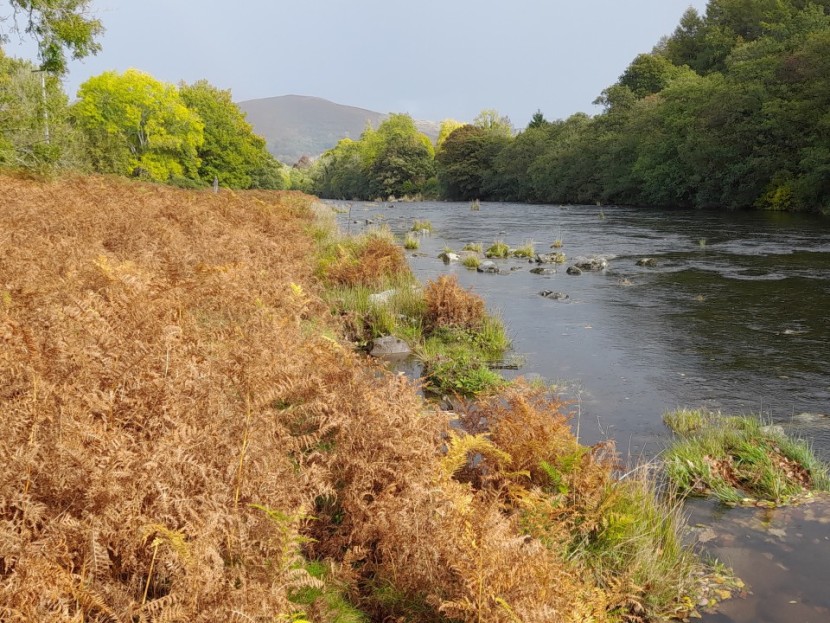 Craig Llyn - AK from Churt
Craig Llyn - AK from Churt Writing on the first day of the close season, it’s clear that overall we have just finished an awful year for Wye salmon. Currently the total rod-caught number stands on 376. This is not the worst recorded ever, and is in fact very slightly more than the totals recorded in 2021 and 2019. However, and importantly, 303 of those fish were taken below Monmouth, and therefore it follows very few from the classic beats further upstream. Doubtless a few more reports will creep in over the next days, but it has obviously been a very bad year and we can assign this to the extended drought combined with two heat waves. It was in fact a classic drought situation, all too familiar in recent years on the Wye, in which most fish were taken just above the tide at beats like Bigsweir and Wyesham, while the upper and middle river were starved. There just wasn’t enough water for the fish to run up. There is always the possibility of course that fish might run now in the short time left before spawning; I haven’t seen much sign of it although there has been some high water. We don’t have accurate figures for the Usk, but that river also seems to have experienced a very poor season, with just a few from the lower reaches and mainly at the back-end. The Towy has done rather better: Abercothi reported 93 fish for the year, which about equals the beat’s five year average. No doubt there will be further post mortems on the salmon results in the coming days and weeks.
On the 18th October DE from Menithwood with a friend took 10 grayling to 12 inches at Lyepole. The Lugg has continued to supply what seems this year to be an inexhaustible supply of middling sized grayling, despite water levels remaining low. A lot of these have been taken on the dry fly. The main Wye, on the other hand, perhaps due to water level fluctuations, has been rather disappointing in this respect. With few fish rising, most anglers on the Wye resorted to nymphs. We were also starting to realise that, so far, the autumn has been remarkably warm. All through October the air flow has been coming from the Atlantic south of Portugal, bringing plenty of heavy showers, but with warm sunshine in between. The second half of October felt more like early September or even August at times, memorable for pensioners nodding on park benches in the sunshine. The rain which did arrive filled up the upper branch of the Wye at Llangurig, the Irfon and so down the main river, so we did have proper salmon running conditions at end. The Lugg, Arrow and Monnow system remained relatively unaffected, as did the Usk. On the 20th DJ from Halesowen had 13 grayling at Lyepole, although he had to work for them according to his account. AG of Harleston reported 13 grayling to 12 inches from the Glyndwr Prteserve, although the Dee was also high. The end of the month was rather quiet.
 Doldowlod
Doldowlod 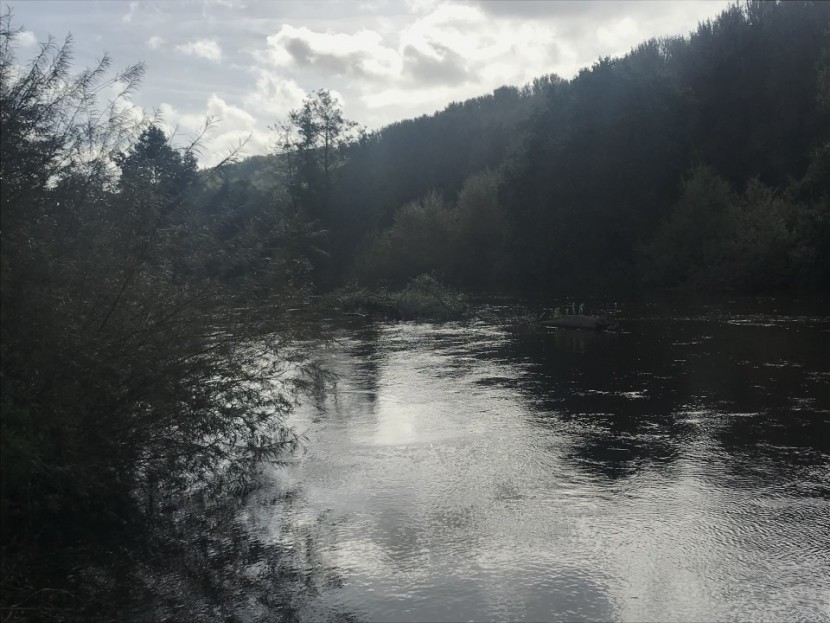 Flood on the lower Wye - CM from Keynsham
Flood on the lower Wye - CM from Keynsham River Wye coarse fishing went on pretty successfully, mostly involving chub and barbel fishers. There were some complaints however. DS from Gloucester felt badly treated due to the noise and disturbance of timber cutting on the bank at Dean and Chapter. Now there is a warning on the website about this work due to continue for two weeks and a suggestion that anglers wanting a quieter time should try another part of the beat. Were it me, having read that, I think I would have picked another beat for that particular trip. However, having given a clear warning, I don’t see that it was necessary for the owners to close the beat entirely. SW from Surbiton had a bad day at Upper Breinton on the 22nd, spending a total of 6 hours extracting his car back up the steep and muddy access road. The AA having failed, a local farmer finally managed to pull him up with a tractor. Since I sold the old Landrover, I have necessarily been a lot more careful about where I take my 2WD car. In the beat description for Breinton there are detailed notes about the access track and likely problems after in wet weather. At the end of the day, the local farmer and his tractor might turn out to be the final resort, so it’s always good to keep on the right side of him! However, OL from Richmond on Thames experienced what sounded like an angry exchange with a farmer at Whitney Court, due to being still present on the bank (according to OL) one hour after sunset. If that timing is accurate, he was within the terms of his ticket agreement, so in this case it might be a good idea for the WUF to ask the fishery owner to contact the farmer and make sure he understands the rules. Alternatively, if packing up late is going to cause a problem locally, it might be necessary to vary the timing on this particular ticket. Finally PV from Rhondda Cynon Taff complained on the 23rd that he had seen on the 21st either poaching or rule breaking on the Llwyn On reservoir. What was done about this on 21st October please PV?
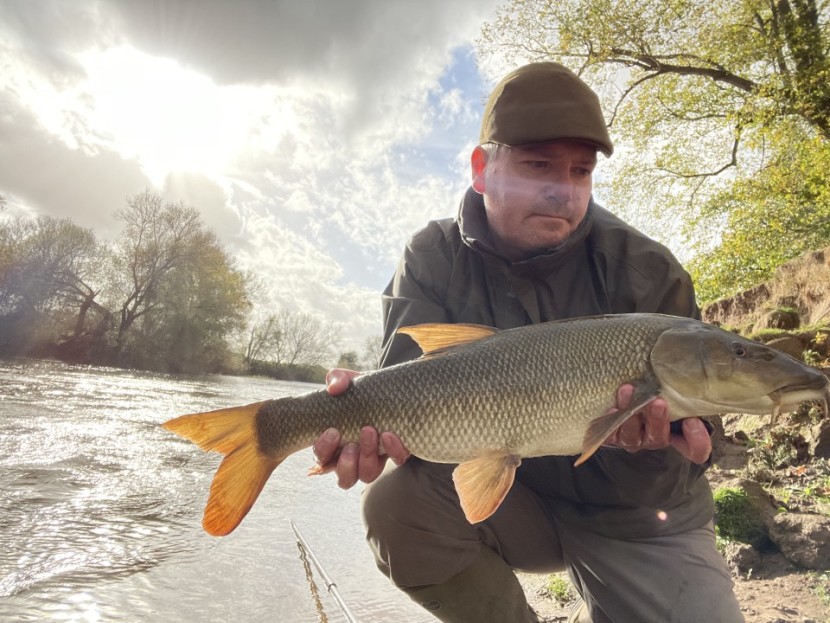 barbel fishing good as ever - AS from Maldon
barbel fishing good as ever - AS from Maldon 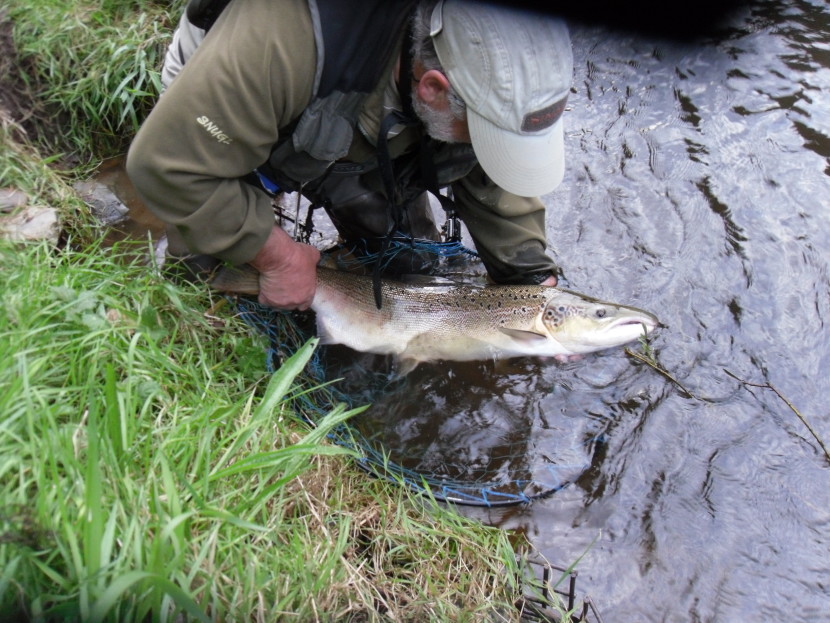 Usk at Kemeys Commander
Usk at Kemeys Commander The October issue of Trout and Salmon carries an interesting article about late season spinning for salmon on the Cothi with Llandeilo club chairman Anthony Peynado and editor Andrew Flitcroft. Those anglers who like to spin complain with some justification that the mainstream angling press gives insufficient coverage to their preferred method and to the skills involved. They may feel this article does a little to redress the balance. The Cothi is a fascinating tributary of the Towy, quite unlike its parent river, and it holds big fish at times. The article records a very successful high water session with three fish taken. Peynado also describes experiments with hooks which are making some progress to comply with the new Welsh regulations: so in 2020 he hooked 20 salmon and landed 9; in 2021 he hooked 16 and landed 9. It still strikes me that a lot of fish are coming off. Incidentally, you can book a ticket to fish this beat via the WUF Passport.
“Where did you get it exactly?”
“The usual place, just by the power lines.”
I have listened to conversations like that more than once. Now I would be the last to suggest that anybody risks electrocution by waving carbon rods around close to high tension power cables. Don’t take any risks. However, given sensible precautions in what we do and don’t do, am I the only one who has noticed that quite often the hotspot for salmon turns out to be close below or even under power lines crossing high overhead? I can think of four such places on our rivers and a couple more for sewin further west. Mark Paterson in his interview in the same edition of Trout and Salmon mentions a general acceptance by the scientific community of electromagnetic sensitivity in salmon, as does Topher Brown in his Atlantic Salmon Magic. Do power lines high overhead create an electromagnetic field which acts as a block, inhibiting fish from migrating further upstream? Or is the field actually attractive?
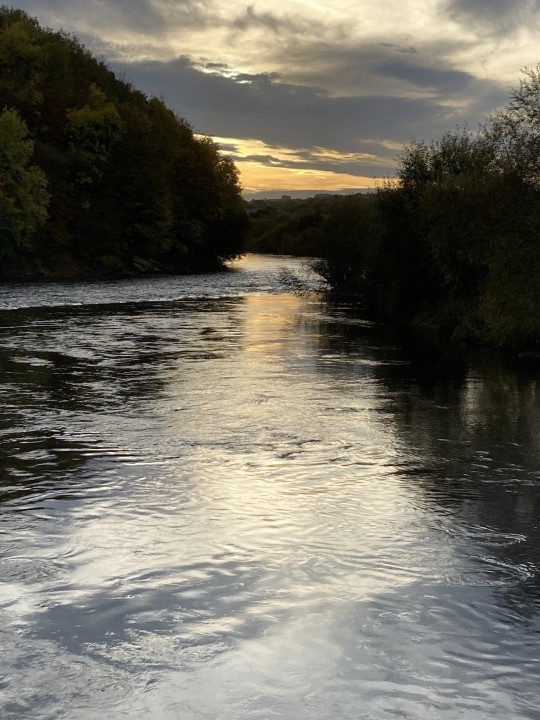 Fownhope - LH from Loughborough
Fownhope - LH from Loughborough 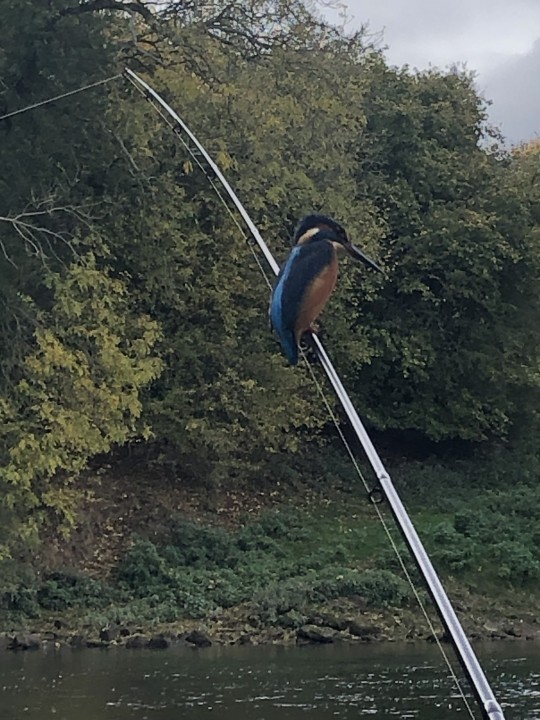 Strangford - NM from Shoreham by Sea
Strangford - NM from Shoreham by Sea It’s regarded as normal for old chaps like me to moan about how expensive everything has become. However, this really is a time of high inflation, something I thought had been left behind with the seventies. We all know about the high fuel costs due to the Ukrainian war and this is certainly impacting on many people’s lives and even, dare I say it, fishing trips. Thankfully the fuel prices are coming down a bit now, but we learn that the drop in oil prices is not being handed on to the consumers in its entirety. Some of it is being held hack by the wholesalers. Call me cynical, but why are we not surprised by that?
Food is more expensive and pubs and restaurants certainly are. Similarly there has been a huge increase in the price of most fishing tackle items. In most cases the rises are disguised by renaming and rebranding products. Smoke and mirrors are in full play here. When a company comes up with a new range of fishing rods every year, it is difficult to compare like with like. Of course the trend is relentlessly upward. Quite a few years ago we entered the age of the thousand pound trout rod, but that only affected some of the most exclusive products from the most exclusive companies. They weren’t rods you actually needed. (Or were they? Friends have often accused me of being prepared to let the family starve in favour of some glittering and unnecessary toy which I convinced myself I needed. I have a very understanding wife.)
The noticeable change today is in the middle of the market. I used to make a speech to clients new to the sport and thinking of buying their first trout rod, telling them that buying a fishing rod is like buying a watch. We can’t all afford to have a Rolex, but you don’t want the cheapest one either. So not so long ago, I would advise that a well-judged expenditure of 250-275 pounds would get them an excellent product from a famous company, one which would give them fishing pleasure over a life time provided they didn’t stand on it or slam it in a car door. Now we are talking about 375-425 pounds for the same thing, although of course the name has changed. It’s much the same when the subject is a double-handed rod: what might once have cost around 400 pounds is now around 600 pounds.
I drove past Sweet’s Tackle Shop in Usk Town a couple of times this month. When I go down Porthycarne Street, I always make a point of pulling over if it looks like Jean Williams has the shop open. If she is there, a pleasant kind of ritual follows: a cup of tea, a slice of home-made cake usually, and then a good old gossip about the river and the characters connected with it. Believe me, if there is gossip to be had, Jean will know it. She always asks about my family, particularly our daughter, whose career she has followed with genuine interest since she was a little girl. Then I usually look through her shelf of second hand angling books, and very often I find what I consider to be a literary treasure. I’m about to review a copy of Francis Francis’s Book on Angling which I think I found in Sweet’s. The circulation of these old fishing books follows a familiar pattern. An elderly angler who has over the years collected books which give him great pleasure, eventually, in the nature of things, pops off. The widow sooner or later makes her way to Sweet’s Tackle Shop, the only likely purchaser, and sells the library. Another, slightly less elderly angler, rummages along the shelf to find something he has been looking for over the years, mutters “eureka” to himself, pays for it and bears it home in triumph. A few years later, the process repeats itself. I bet some of these books have been through Jean’s hands several times.
It’s a relaxed sort of place, Sweet’s Tackle Shop. More than once Jean has come up with something like: “Do you mind looking after the shop for 10 minutes? I have to nip down-town and pick up the Sunday joint.” So there I would be for a quarter of an hour, lord of all I surveyed and in charge of the emporium, the oldest tackle shop in Wales. All sorts of people are likely to drop into Sweet’s; I can recall meeting the last of the Thames professional punt fishermen and a couple of times Jon Beer. But lately, every time I have passed the shop, the blind has been rolled down over the door to show that Jean is not in residence. I got as far as knocking on the door the other day, thinking she might just be dressing flies in the back, because I had an Usk salmon to report and Jean keeps a register. I was not too much worried about the lack of response, because in recent years Jean has been cheerfully vague about what her opening hours are. Nobody ever blamed her for this and you could pay for a ticket on the Town Water if you wanted to fish by pushing an envelope under the door. Now they tell me that Jean has decided to retire at last and close the shop which has supported the anglers of Usk for nearly a century while in the hands of Harry Powell, Molly and Lionel Sweet and then Jean Williams. I remember that once, many years ago, I asked Jean if she ever considered retiring and if so would she sell the shop? She practically chased me out the door with a broom. Ah well, times move on, but it won’t be the same on the Usk without Sweet’s.
 Autumn in the lower Usk valley
Autumn in the lower Usk valley  Chainbridge
Chainbridge I was sorry to hear that Major Patrick Darling, owner of the Caradoc beat, died earlier in October. Once a trustee of the WUF he always did as much as he could to support the river and Herefordshire. Caradoc is one of those classic middle Wye salmon beats, deep and slow in places, perhaps more suited to the spinner than the fly. I remember one spring watching a canny old hand spinning the traditional way, bumping a Wye lead slowly along the bottom with a wooden minnow rotating a yard behind. Patrick Darling was a keen hunter and some handsome tall horses used to be kept in the fields along the river. Nowadays the barbel fishermen probably know this beat better, or you might have attended the Herefordshire Show which was regularly hosted at Caradoc.
Some rivers, or at least some pools and channels in rivers, don’t change much over the years. These are the ones bounded by outcropping rocks, worn smooth by the water over centuries, but more or less keeping the line of flow intact. Such rivers won’t prevent shingle moving around in pools with every major flood, but the margins will remain defined. The roots of oaks and alders knotted into the banks of upland streams have a similar effect although I wouldn’t have such confidence in the willow trees which grow along streams at lower altitudes. And when any river begins to flow through sediments of sand and deposited shingle, un-bonded by rocks, trees or man’s defensive bank works, it begins to wind like a snake, moving many feet each season, cutting on the outside of bends and depositing shingle banks on the inside. So it goes on until at last the bends are so exaggerated that the water breaks through and an ox-bow lake is formed, which will last for a time until it silts up and turns first into a bog haunted by water birds and then eventually perhaps no more than a depression in the pasture shows where the river channel once ran. You can see all of these different features in the valley of the upper Wye, from the rock-bounded channel between Builth and Glasbury to the open winding river cutting through Herefordshire fields below. If you walk beside the Usk in the fields by Brecon, you can clearly see where the river used to run. In fact there is this characteristic of all moving water, from the lowland parts of the Monnow to the brooks in the Passport scheme, in that the channel will move given half a chance. The river is eternal, but the channel is not. Water pushes, cuts, erodes, wears, transports and deposits all at once. Certainly we should never underestimate the power of only one big winter flood. I was amazed this spring on my first visit to Ty Newydd to see how much gravel had moved during the winter in the Bachawy pool. I would estimate that thousands rather than hundreds of tons moved and can only imagine what damage was done to salmon redds.
For the most part, given the low value of agricultural land, man is now content to sit back and let the river have its way rather than defend the channel with expensive deposited blocks of rock and concrete. Urban rivers and valuable bridges are another matter. An artificially wide channel defended by made up banks or walls is usually the solution where houses and streets need to be defended. Usk Town where you can walk by the river is a nice example of that. Modern bridges are usually constructed over suitably deepened and wide pools where flood water will never be constricted to gain dangerous force. Even older bridges were commonly constructed with additional dry arches at the side to relieve flood water pressures.
I recall learning about rivers and many connected matters in school from a particularly gifted geography master, who used the statistics and diagrams of the great Mississippi as his main and vivid example. I particularly remember his description of the Mississippi levees, originally formed of silt deposited at the sides of the river during floods until eventually you had embankments which could actually raise the river level well above that of the surrounding fields. To my surprise I found I was actually able to define levees on a much smaller scale beside Thames tributaries or indeed anywhere a river carrying silt winds through flatlands. My little local River Wey was hardly the Mississippi, but like the American giant it was building up its banks a little with silt on every winter flood. In places you could walk along the raised bank and look down at the fields!
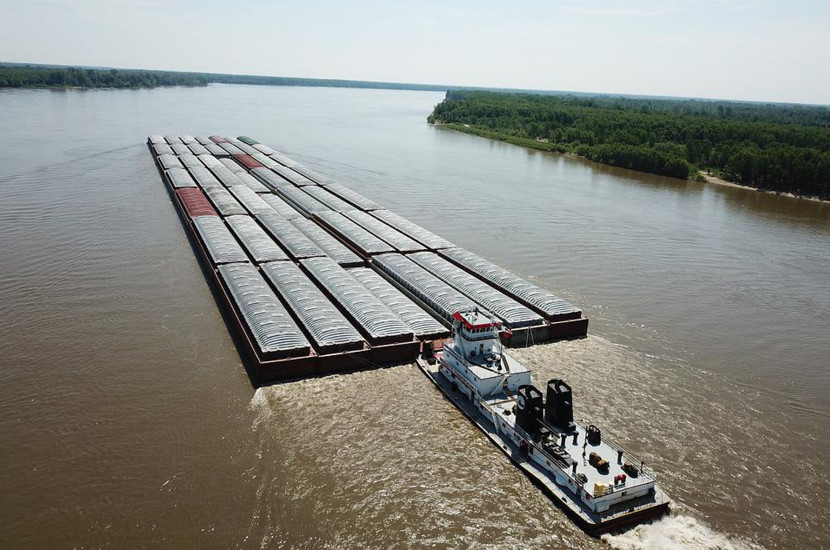 Mississippi - the great water highway
Mississippi - the great water highway 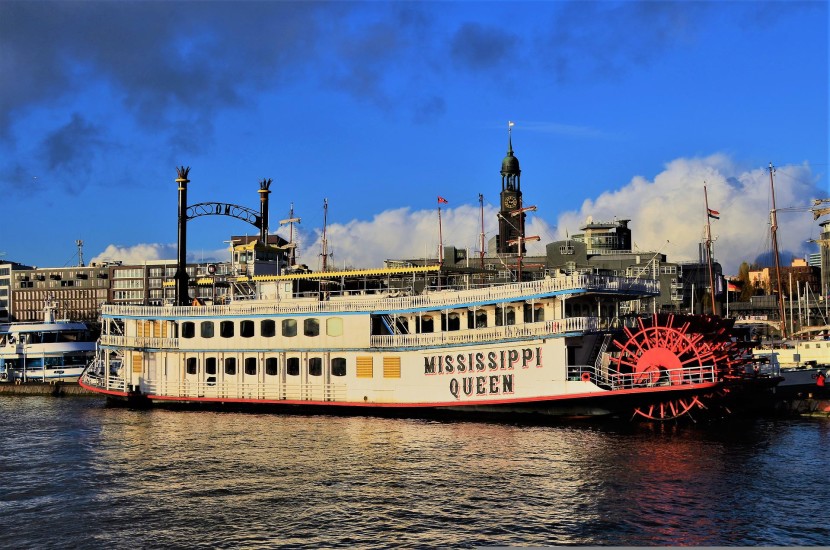 The last sternwheeler
The last sternwheeler Historically there was also the need for navigation and the construction of leats and canals for mills when water power was once a common resource throughout our land. Man has been fighting nature over the movement of water and river banks for centuries, although most of the early wooden constructions have disappeared. Thus we are left with conjecture and the evidence of a few old drawings and prints to work out how it was all done. I don’t pretend to understand exactly how the Wye was held back and controlled at times and in places to get trading trows up to Hereford; only that there were not locks as we know them today.
Completely artificial channels are something different. The great age of canal building in this country spanned the 17th and 18th century and many of them are still in place and in use so that we can see what was done and why. There is plenty of evidence of canal building attempts in antiquity, although many were failures. The Corinth Canal, completed by the modern Greek state in 1893, was first attempted by Periander seven centuries BC. Perhaps Periander could have saved himself the trouble; the current four mile canal cut through the isthmus is beset by rock falls, regularly closes for repairs and has never made much money. More famous and highly successful modern canals are of course the Suez, cut between the Mediterranean and Red Sea by de Lesseps in 1869 and the Panama completed between the Atlantic and the Pacific in 1914. By the late 19th and early 20th centuries, engineers and particularly Americans were seemingly prepared to confront powerful waters on almost any scale as the world entered the great age of dam building.
It was a logical progression because the demands of the American Civil War had already provoked remarkable advances in engineering. This was of course the first major war in which the realities and horrors of the battlefield were brought home to the newspaper reading public by the new science of photography. It was also the first truly industrialised war and the first one in which the railroad network and river steam boats played an important role. I have always been interested in that particular piece of history, but I needed to read the detail to understand more about its naval aspect. Usually Gettysburg is described as the major pivotal battle, the one in which the eventual course of the war and the triumph of the Union was determined. In fact, despite the drama of Gettysburg, the emotional impact of the huge losses there and its effect on the peoples of both North and South, it was probably not in itself the crucial event. During a continental war, the phases of which became divided into eastern and western theatres, control of the Mississippi was more likely the critical element.
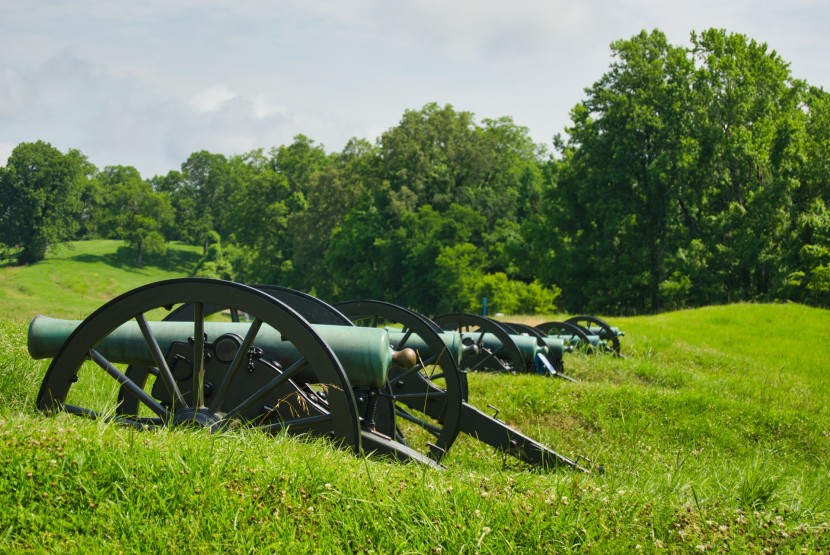 Vicksburg
Vicksburg 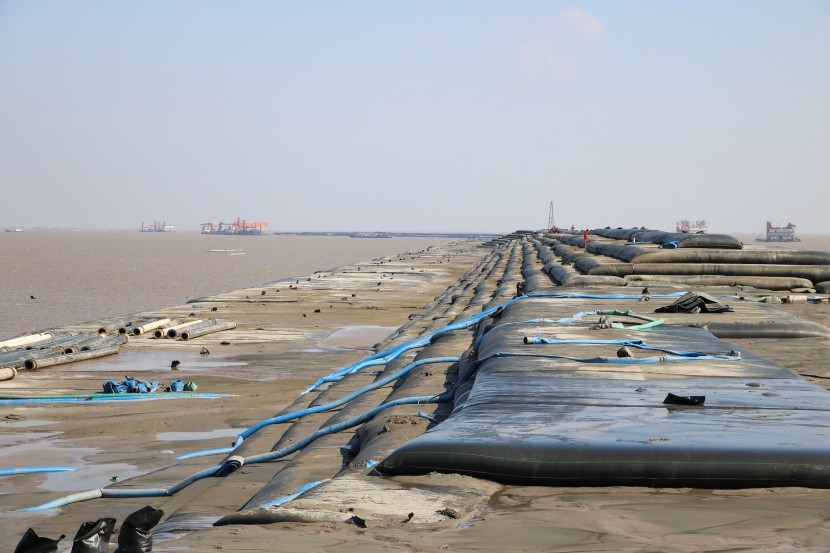 Levee - sandbag reclamation
Levee - sandbag reclamation By the end of 1862 Ulysses Grant, then one of three commanders of Union forces in the area, was sitting with his Army of Tennessee on the Upper Mississippi. Union naval forces already held New Orleans and Baton Rouge at the bottom of the river. The huge distance in between was effectively blocked by Vicksburg, a Confederate stronghold bristling with guns on a bluff overlooking the river. The belief was that Union vessels proceeding either upstream or downstream would never be able to run the river past the Vicksburg forts, which faced a hairpin bend on the Louisiana side of the river and was only approachable by land from the east or Mississippi state side. There were some confused notions about what should be done, but Grant at least was convinced that Vicksburg and the Mississippi would turn out to be the key to eventually winning the war.
A whole series of schemes were tried that winter to solve the problem of by-passing Vicksburg, all of which involved cutting through the levee. The first, amazingly, is that sappers tried to cut a canal through the strip of land in the neck of the bend opposite Vicksburg, therefore capable of taking steam boats downstream and by-passing the guns entirely. Sherman’s engineering corps undertook the work, but the river refused to enter the cut in a volume sufficient to float steam boats. Another idea was to make a cut from the main river on the Louisiana side 50 miles upstream from Vicksburg across the watershed into Lake Providence and from there work to deepen some minor streams leading as far as the Red River, re-entering the Mississippi 150 miles below Vicksburg. After a couple of months this was abandoned as it became obvious that the deeper draft boats available would not be able to make the passage. There was also a plan to cut through the levee 300 miles north of Vicksburg and send steamers into the Yazoo, which would eventually provide an opportunity to land assault troops just above Vicksburg on the landward side. This looked like working for a time, but they were blocked at the junction of the Tallahatchi and Yalabousha by the Confederate Fort Pemberton, where the batteries, while not as powerful as those of Vicksburg, were strong enough to drive the Federal steamers back upstream to the Mississippi. And finally an expedition from New Orleans tried to make its way from downstream up into the Yazoo and a maze of small streams to reach the same place, but failed to drive the steam boats through the narrow and willow-choked channels. The Federal flotilla tried to fight their way through a jungle of overgrown marshes where Confederate troops sniped and felled trees behind them, only regaining the Mississippi again with difficulty.
When just about everything else had been tried, Grant adopted the obvious if dangerous plan, and took a calculated risk to get his troops onto the eastern side of the river where they could threaten the Confederates in Vicksburg. In May 1863 he marched his army down the Louisiana side of the river through forests and swamps to a position some 30 miles below Vicksburg. Then in the middle of the night his empty gunboats ran the gauntlet of terrifying shelling from the fort’s batteries, but survived to rendezvous with the army downstream. 33,000 soldiers then crossed in them to the Mississippi side. Grant immediately made for Jackson the state capital, this being the only direction from which aid could come to General Pemberton’s force in Vicksburg. Jackson secured, Grant fought and won a battle against Confederate troops at Champion’s Hill before chasing Pemberton back into the Vicksburg lines. A couple of attempts to take the Vicksburg defences by storm that month failed, but Grant calmly settled down to starve the garrison into surrender, his Union forces now having built up to 75,000. Gettysburg was fought on the 1st, 2nd and 3rd of July. At Vicksburg, Pemberton surrendered to Grant on 4th July. The whole Mississippi now belonged to the Union and the Confederacy was cut in half. The Confederacy had not lost, not yet. But although the war would last nearly two more years, it was now hardly possible that the South could win. The great river may well have been the deciding factor.
The important role of military engineers had been appreciated from the foundation of the American state. During the Revolution, King Louis XVI was persuaded to supply French-trained engineering officers to the Continental Army, thus establishing a corps of engineers from the beginning. The national headquarters were always to be based at West Point and this particular branch of the Army was highly regarded. Of Civil War generals, George Meade and George MacClellan were professional engineering officers fighting for the Union, while Robert E Lee and PGT Beauregard were engineering officers fighting for the Confederacy. During the war years a Confederate Corps of Engineers was created as a mirror image of the Union model.
Later in peace as well as in war, the idea that massive infrastructure projects might be best managed by the US Army Corps of Engineers has usually proved successful. Just to take a few very disparate examples, the Panama Canal, the Bonneville Dam, Washington’s Pentagon, and the Manhattan Project at Los Alamos were all undertaken under the Corps’ management. Above all, today the Corps continues to be responsible for flood defences and the control of continental rivers. It is responsible for dam safety, hydro-electric power, and the water supply for 10 million Americans. The Corps manages 12,000 miles of navigable waterways, 257 locks and 609 dams. 67% of the nation’s goods and more than half its oil supply currently pass through ports under US Army Corps of Engineers’ control. The Corps is also increasingly involved in issues of environmental protection. It would be an interesting exercise to make a comparison between the operations of this giant and our own Environmental Agency. The regions of responsibility of the Corps are divided into five divisions. The Mississippi Valley Division, which stretches from Canada to the Gulf of Mexico, is still managed from Vicksburg.
(Thanks to Bruce Catton’s The Civil War for an account of the river boat war).
Politics is a blood sport in this country, as we are reminded quite regularly. The brief hiatus in campaigning activity while mourning the late Queen was welcome. Since then, what a month it has been as renewed civil war in the Conservative Party returned to depress and infuriate those of us unfortunate or unwise enough to be of the Tory persuasion! As the melodrama reaches new heights it is all getting rather difficult to keep up with. Who is PM this week? Who is Chancellor of the Exchequer? Who appointed them and do the markets, the IMF and the BBC approve? My wife sent her membership card back with a suitable remark scrawled across it and the party’s website crashed as thousands of other members tried to resign. I have watched coup attempts in Tunisia, Spain and one or two other places, but, believe me, there is nothing to be found anywhere quite as implacable and deadly as those men in grey suits operating in Westminster to get their preferred candidate in place. They didn’t even need to send tanks onto the streets. Instead we are now being reassured that the broad base selection of the latest cabinet means that good government will automatically follow. Wouldn’t it be pretty to think so, but I have my doubts. In fact I have to concede there is nothing very democratic about the present situation and mandate, to the extent that if they had any sense of decency and fairness our latest Conservative rulers would now call a general election….which inevitably would result in a long period in opposition, and which would probably do them some good. But they haven’t, so they won’t. They will cling on with all twenty fingers and toes as long as they can. I imagine that in a few weeks they will be at each other’s throats again. Truly, the party which has so damaged itself and wasted opportunities to serve the country does not deserve to be in power. When I lived and worked in the Balkans I didn’t pay much attention to UK politics, figuring that I already had enough to deal with locally. I avoided a lot of disappointment that way.
As always, I feel better thinking about fishing. It’s the trotting and bugging season next. Tight lines for grayling!
Oliver Burch
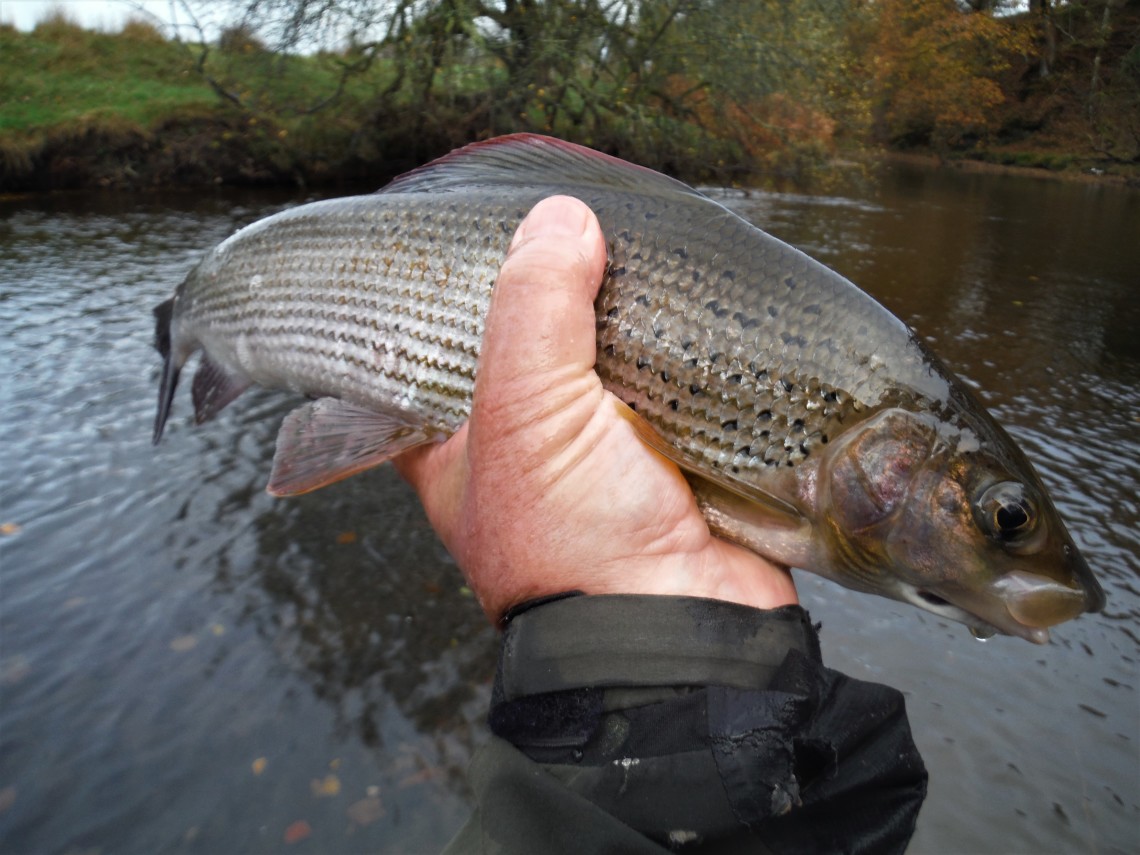 Upper Irfon grayling
Upper Irfon grayling